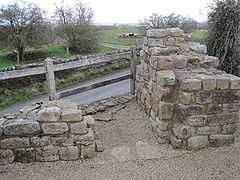Pike Hill Signal Tower
Coordinates: 54°58′33″N 2°39′47″W / 54.975955°N 2.662937°W
| Pike Hill Signal Tower | |
|---|---|
|
The remains of Pike Hill Signal Tower | |
 Pike Hill Signal Tower | |
| OS grid reference | NY57666479 |
Pike Hill Signal Tower was one of a number of signal stations that were built along the Roman Stanegate in northern Britannia during the early 2nd century. It later became incorporated into Hadrian's Wall. Its remains, a 2-metre (6.6 ft) long fragment of the south-east wall, lie south of a modern road cutting and field wall, and are located in the parish of Waterhead in Cumbria, United Kingdom. The tower is located between Turret 51B and Turret 52A with the fort of Banna located to the east.
History
A signalling tower was built on Pike Hill during the Stanegate phase of fortifying the northern frontier of the Roman province of Britannia.[1][2] Signalling towers and a number of forts were built along the line of the Roman road that connected significant military forts at Corbridge and Carlisle. This followed the withdrawal of the Roman army from Scotland around 100 and was prior to the construction of Hadrian's Wall which started in 125.[1] The station at Pike Hill signalled to two nearby stations, Gillalees Beacon and Barrock Fell.[3]
As Hadrian's Wall was extended through the area, the signal tower came to be incorporated alongside the newly constructed wall. The tower's location put it about 200 metres (660 ft) east of Turret 52A (Banks East) and west of Turret 51B (Leahill Turret).[4][5]
It has been suggested that the signal tower was manned by part of Milecastle 52's garrison. The extra size of Milecastle 52 (20% larger than any other milecastle) has been cited as evidence for this.[6]
Construction
Archaeological investigations have shown that the tower was built prior to either the turf or stone walls that exist nearby.[7] The tower was offset from the wall and stood at an angle of 45° to the line of the wall. The purpose of this was to improve the visibility of the signal.[6] A ditch lies to the north of the tower, following the same course as the tower resulting in a zig-zag line.[4]
The signal tower was a square structure measuring around 6 metres (20 ft) on each side.[6] The tower was built on a platform of mortared rubble and deep foundations have been found which indicate an upper structure of some extra height.[7] The masonry was finished to a higher standard than the turrets found on the wall.[4]
Excavations and investigations
- 1931 - The remains were excavated and consolidated. Finds included:
- Pottery dating to the Hadrianic period;[8]
- Rims of cooking pots known as Huntcliff ware, indicating occupation as late as the latter half of the 4th century.[8]
- 1971 - English Heritage Field Investigation. It was noted that the modern road cutting has led to the destruction of the majority of the structure, only a fragment of the south-east wall remaining visible.[9]
Monument records
| Monument | Monument Number | English Heritage Archive Number |
| Pike Hill Signal Tower | 12700[7] | NY 56 SE 18[7] |
References
- ↑ 1.0 1.1 Sheldon, Rose Mary (2005). Intelligence activities in ancient Rome: trust in the gods, but verify. London: Frank Cass. pp. 208–209. ISBN 0-415-45271-6.
- ↑ Richards, Mark. Hadrian's wall path national trail: walk the Roman frontier. p. 162.
- ↑ Richards, Mark (2008). The Spirit of Hadrian's Wall. Cicerone Press. p. 161. ISBN 1-85284-558-9.
- ↑ 4.0 4.1 4.2 Collingwood Bruce, J (2006). Handbook to the Roman Wall (14th ed.). Newcastle-upon-Tyne: Society of Antiquaries of Newcastle upon Tyne. ISBN 0-901082-65-1.
- ↑ "Get-a-map". Ordnance Survey. Retrieved 25 May 2010.
- ↑ 6.0 6.1 6.2 Breeze, David J (1934), Handbook to the Roman Wall (14th Revised edition - Nov 2006), Society of Antiquaries of Newcastle upon Tyne, p. 65, ISBN 0-901082-65-1
- ↑ 7.0 7.1 7.2 7.3 "Pike Hill Signal Tower". Pastscape. English Heritage. Retrieved 25 May 2010.
- ↑ 8.0 8.1 "Transactions of the Cumberland and Westmorland Antiquarian & Archaeological Society" 33. 1933. pp. 271–272.
- ↑ English Heritage Field Investigators Comments, F1 DS 11-NOV-71, 11 November 1971
External links
| Wikimedia Commons has media related to Pike Hill Signal Tower. |
| ||||||||||||||||||||
| ||||||||||||||||||

